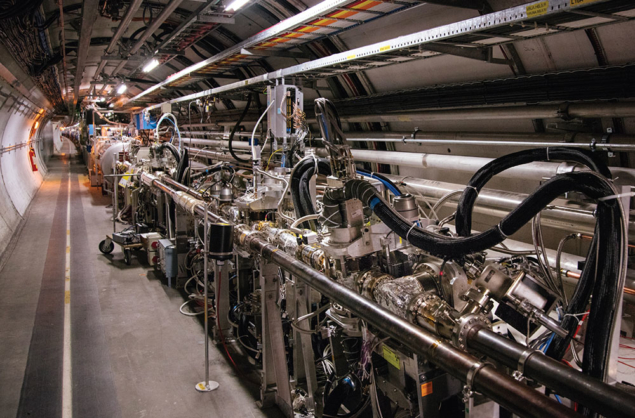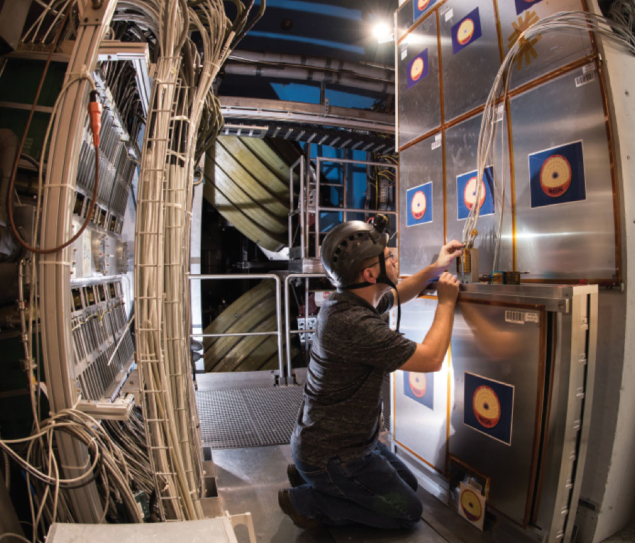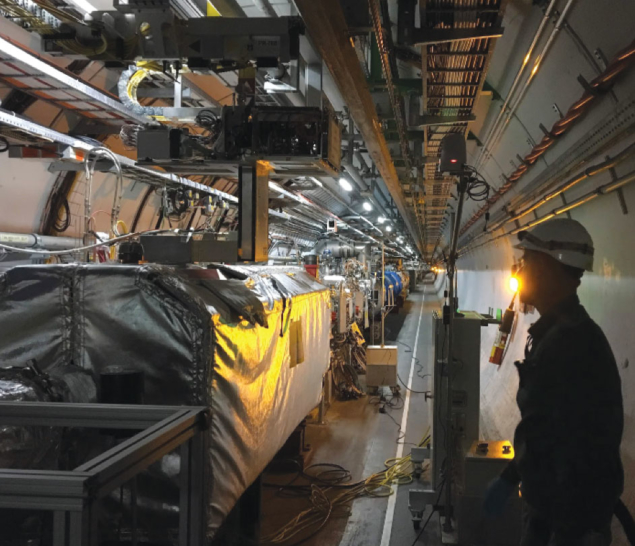The LHC lies dormant, its superconducting magnets drained of liquid helium to be brought back to room temperature. Along with the rest of CERN’s accelerator complex, the LHC entered long-shutdown two (LS2) on 10 December.

The features in this first issue of 2019 bring you all the shutdown news from the seven LHC experiments, and what to expect when the souped-up detectors come back online in 2021.
During the next two years of long-shutdown two (LS2), the LHC and its injectors will be tuned up for high-luminosity operations: Linac2 will leave the floor to Linac4 to enable more intense beams; the Proton Synchrotron Booster will be equipped with completely new injection and acceleration systems; and the Super Proton Synchrotron will have new radio-frequency power. The LHC is also being tested for operation at its design energy of 14 TeV, while, in the background, civil-engineering works for the high-luminosity upgrade (HL-LHC), due to enter service in 2026, are proceeding apace.
The past three years of Run 2 at a proton–proton collision energy of 13 TeV have seen the LHC achieve record peak and integrated luminosities, forcing the detectors to operate at their limits. Now, the four main experiments ALICE, ATLAS, CMS and LHCb, and the three smaller experiments LHCf, MoEDAL and TOTEM, are gearing up for the extreme conditions of Run 3 and beyond.
At the limits
Since the beginning of the LHC programme, it was clear that the original detectors would last for approximately a decade due to radiation damage. That time has now come. Improvements, repairs and upgrades have been taking place in the LHC detectors throughout the past decade, but significant activities will take place during LS2 (and LS3, beginning 2024), capitalising on technology advances and the ingenuity of thousands of people over a period of several years. Combined, the technical design reports for the LHC experiment upgrades number some 20 volumes each containing hundreds of pages.

For LHCb, the term “upgrade” hardly does it justice, since large sections of the detector are to be completely replaced and a new trigger system is to be installed (LHCb’s momentous metamorphosis). ALICE too is undergoing major interventions to its inner detectors during LS2 (ALICE revitalised), and both collaborations are installing new data centres to deal with the higher data rate from future LHC runs. ATLAS and CMS are upgrading numerous aspects of their detectors while at the same time preparing for major installations during LS3 for HL-LHC operations (CMS has high luminosity in sight and ATLAS upgrades in LS2). At the HL-LHC, one year of collisions is equivalent to 10 years of LHC operations in terms of radiation damage. Even more challenging, HL-LHC will deliver a mean event pileup of up to 200 interactions per beam crossing – 10 times greater than today – requiring totally new trigger and other capabilities.
Three smaller experiments at the LHC are also taking advantage of LS2. TOTEM, which comprises two detectors located 220 m either side of CMS to measure elastic proton–proton collisions (see “Forging ahead” image), aims to perform total-cross-section measurements at maximal LHC energies. For this, the collaboration is building a new scintillator detector to be integrated in CMS, in addition to service work on its silicon-strip and spectrometer detectors.

Another “forward” experiment called LHCf, made up of two detectors 140 m either side of ATLAS, uses forward particles produced by the LHC collisions to improve our knowledge about how cosmic-ray showers develop in Earth’s atmosphere. Currently, the LHCf detectors are being prepared for 14 TeV proton–proton operations, higher luminosities and also for the possibility of colliding protons with light nuclei such as oxygen, requiring a completely renewed data-acquisition system. Finally, physicists at MoEDAL, a detector deployed around the same intersection region as LHCb to look for magnetic monopoles and other signs of new physics, are preparing a request to take data during Run 3. For this, among other improvements, a new sub-detector called MAPP will be installed to extend MoEDAL’s physics reach to long-lived and fractionally charged particles.
The seven LHC experiments are also using LS2 to extend and deepen their analyses of the Run-2 data. Depending on what lies there, the collaborations could have more than just shiny new detectors on their hands by the time they come back online in the spring of 2021.





